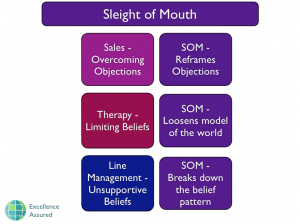NLP Sleight of Mouth Patterns. They have a mischievous, fun and adventurous kind of name, some might say, like Richard Bandler himself. These patterns were modelled from Richard Bandler by Robert Dilts and Todd Epstein. They realised that Richard said things on a regular basis that completely bamboozled people. What he said just seemed to take the wind out of any argument that someone might have, it seemed to denergise the argument. Richard was thought to never lose an argument and so they thought that there must be something in these language patterns that he used.
They modelled the language and the patterns that he seemed to use and that became the NLP Sleight of Mouth patterns.
Sleight of Mouth patterns are more than reframes. They utilise the values that are inherrent in someones belief thinking or generalisation on a subject which you can then utilise back to them.
 Some NLP schools call these patterns Criteria Utilisation patterns, they are the same thing.
Some NLP schools call these patterns Criteria Utilisation patterns, they are the same thing.
Now, if we think about how important that beliefs are in our life. For those of us that are running an unuseful belief, beliefs have major influence on our capabilities, on our behaviours and on the results that we get. If we are running an unuseful belief or we are around someone who is running an unuseful belief, the chances are that they have taken a behaviour either inside or outside themselves and they have generalised themselves upon it and made some kind of inappropriate assumption.
Those Cause and Effect statements those Cause and Effect beliefs that we run, those Complex Equivalences that don’t serve us are absolutely amenable to Sleight of Mouth interruption. Because Sleight of Mouth are essentially pattern interrupts on behaviours, on beliefs generalised on behaviours. The reason that we might want to use them is if someone is running an inappropriate belief then can we assist them to disconnect that external behaviour about which they are generalising an internal belief?
Can we assist that effect, that feeling of how they feel about something and get them back at cause about it?
Can we have them perphaps attend to or think about another value instead of the one that they are running as a judgement about someone elses behaviour and therefore have a more useful belief?
Sleight of Mouth patterns work by disconnecting, by interrupting the generalisations that have been made inappropriately. Lets think about an example.
The well used NLP example. “My husband does not buy me flowers= means that he doesn’t love me.”
External behaviour being interpreted at a high value belief inside. Does that support that person? No.
“My boss does not like me he is always shouting at me.” External behaviour construed as internal, high level belief about the bosses behaviour being interpretted for that person unusefully.
So in NLP we use Sleight of Mouth patterns to interrupt a complex equivalence or something causes something unusefully in someones way of thinking.
Now, where do we apply this? Hows about in sales, reframing objections. This is the ultimate tool for reframing any objection. Or assisting someone to think differently about purchasing whatever it is that you have to offer.
What about in therapy? If people are in a situation where they are running a belief that doesnt support them. As a way of loosening the model before you actually start the therapy. This is an equisite tool.
What about in the workplace? If people are hanging on to those sturdy beliefs that unusefully support an organisational culture in a disempowering way, then this is yet another way in addition to the NLP Meta Model to break that belief pattern.
Sleight of Mouth language patterns provide us with 16 different ways to overcome objections, and help someone think slightly differently in order to provide a more positive viewpoint for them on something and we discuss all 16 ways in detail on out NLP Master Practitioner training courses. You can take an NLP training with us at one of our NLP training centres or online at our NLP Online Training Centre.
